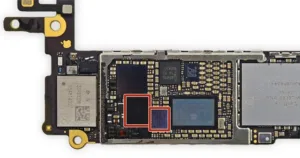iFixit has published a very comprehensive blog post about a problem with the touchscreen on the iPhone 6 and 6+. The problem is apparently becoming so common that ‘microsoldering expert’ Jessa Jones, who runs a shop called iPad Rehab and talked to iFixit, said that most of her time is now spent fixing this one issue.
The symptoms of the problem are a flickering grey bar at the top of the display and an unresponsive touchscreen. Another repair specialist, Jason Vilmer of STS Telecom, said, “I feel like almost every iPhone 6/6+ has a touch of it (no pun intended) and are like ticking bombs just waiting to act up.”
Apple, apparently, cannot fix the problem. The company’s forums are filled with posts (some have been censored by Apple to remove references to how the problem can be fixed by independent shops), several detailing unhelpful experiences with Apple’s Genius Bar. According to employees, Apple is aware of the issue but does not recognise it as a fault.
Crucially, replacing the touchscreen doesn’t fix the problem – at least, not for good. The grey bar will eventually reappear. This is because the problem isn’t on the screen, but in two touch controller chips (U2402 Meson and Cumulus U2401) on the phone’s logic board.
The two chips translate touches into machine-readable information. When they malfunction, it removes the iPhone’s ability to process commands from the touchscreen. Replacing the chips – which Apple’s ‘Geniuses’ are not equipped to do – is the only fix.
iFixit and the repair specialists it talked to cannot say for sure what is causing the defect. However, the most common theory is that it is long-term consequence of a design flaw in the iPhone 6/6+: so-called Bendgate. This was a problem that became apparent soon after the phones were released, where they would bend in owners’ pockets due to their thin, wide profile.
Apple apparently fixed the bending issue in later versions of the iPhone 6/6+. However, the handsets’ design is still inherently weaker than that of other iPhones (the 6S/6S+ have a similar profile but the chips were moved off of the logic board and onto the display assembly). According to Jones, the design puts more pressure on the logic board, especially in the 6+. Over time, as the board twists and flexes, the solder balls that connect the Meson and Cumulus chips to the logic board crack and begin to lose contact. Eventually, touch can become glitchy and then fade altogether.
The only way to permanently fix the phone is to replace the logic board (expensive) or chips (less expensive). Customers in warranty can get this done for free.
Analyst Comment
Apple is facing a difficult year in terms of smartphone sales: its market share is now almost 10% behind Samsung. If this issue is as widespread as iFixit makes it out to be, then it must be acknowledged and handled, before it develops into a larger outcry or even a lawsuit. (TA)

